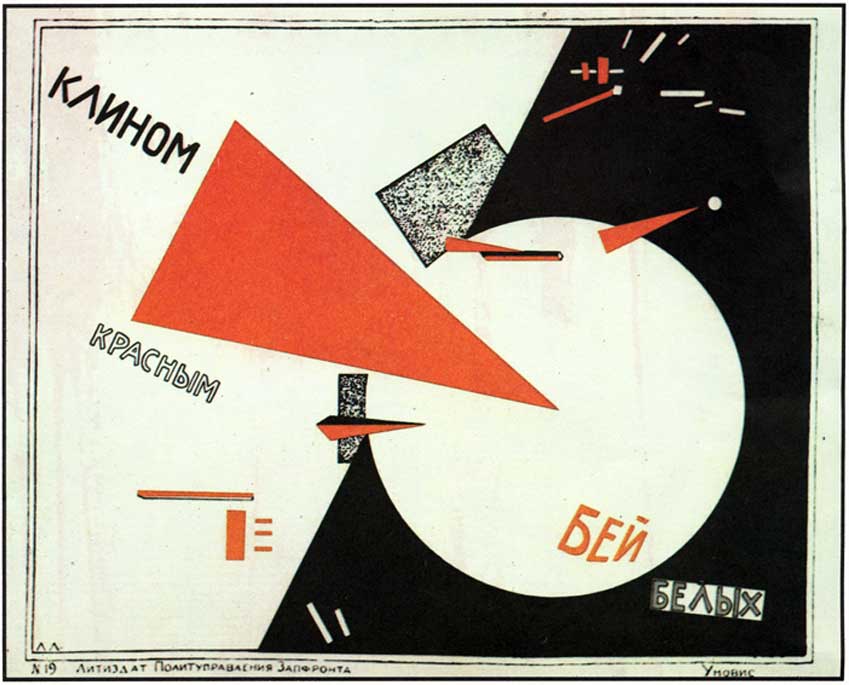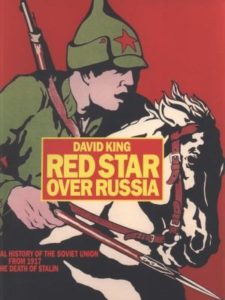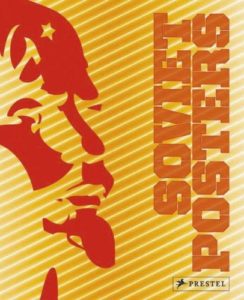Link to the painting by Shimamoto Shozo:
Category: Images
John D. Graham – Cave Canem
Link to the painting by John D. Graham:
Bonus link: “John D. Graham and ‘Another Way of Making Modern Art'”
El Lissitzky – Beat the Whites With the Red Wedge

David King – Red Star Over Russia
David King – Red Star Over Russia: A Visual History Of The Soviet Union From 1917 To The Death Of Stalin Posters Photographs And Graphics From The David King Collection (Abrams 2009)
Red Star Over Russia is one of the best English-language overviews of the birth and early decades of the Soviet Union. This is primarily a collection of visual materials, presented in large format with high-quality printing/reproduction. There are extensive annotations to contextualize the images, which increases the value of the book tremendously. This is really an essential collection. It is a very nearly necessary supplement to written histories and biographies of the era in question. For instance, the war photographs from the Great Patriotic War (WWII) are quite indescribable, and are, alone, the sorts of things every human being should be exposed to as part of a historical education.
There are, however, a few things to note about this book. King is a Trotskyist. So there is a disproportionate amount of material on Lev (Leon) Trotsky, and essentially no criticisms of Trotsky (such as of his well-documented arrogance). There is also a staunchly anti-Stalinist perspective. While documenting Stalin’s crimes is necessary, readers should be aware that the book is tilted against Stalin (and others) in a typical Troskyist way — without, say, the acknowledgment that many Troskytists have made in recent years that elements of Stalinism were inevitable in the USSR or recognizing some of Stalin’s achievements. Anyway, as a book that focuses on visual art, with tangential discussions of the text on propaganda posters and such, readers will have to look elsewhere to lean more about the music and writing over the early Soviet era — like the great writers Andrei Platonov and Mikhail Bulgakov. Moreover, there are a few misleading comments in the book. Take for instance an indication on page 308 that TASS window posters were “hand-painted”. As detailed in Windows on the War, the TASS news agency did release a few window paintings that were free-hand painted on easel, in the manner King implies, but they were very limited in number. More common were (small-scale) reproduced stenciled posters with painterly effects (what today might be called “artisinal” in the West). Although maquettes may have been initially hand-painted, these stencil posters were not free-hand painted. The images on pages 308 and 309 of King’s book are stenciled reproductions (evident by the individual sheets glued together to form the overall image).
The criticisms of this book are all ultimately minor. King’s Trotskyist slant should, however, be noted by readers. Yet King certainly does not hide his outlook, which is commendable. Everyone has an outlook — there is no such thing as “objectivity” in these matters.
Maria Lafont – Soviet Posters: The Sergo Grigorian Collection
Maria Lafont – Soviet Posters: The Sergo Grigorian Collection (Prestel Publishing 2007)
An interesting book reproducing poster art from the Soviet Union from 1917 to the 1980s. All of the reproduced posters come from the private collection of Sergo Grigorian. While many are rare posters — the Soviet government did not value preservation of posters as “art” — this is a somewhat arbitrary and partial representation of what Soviet poster art encompassed. It specifically leans toward posters mass-produced using lithographic techniques. Fortunately, there are numerous other books (in English) on Soviet art that can be consulted to gain a wider perspective, including catalogs of individual artists like Aleksandr Zhitomirsky, Aleksandr Rodchenko, El Lissitzky, Gustav Klutsis, Viktor Koretsky — not to mention in-depth treatments of photography, photomontage, constructivism and socialist realism in general. David King‘s Red Star Over Russia: A Visual History Of The Soviet Union From 1917 To The Death Of Stalin Posters Photographs And Graphics From The David King Collection is also a more comprehensive multi-media collection of Soviet historical and artistic materials, with explanatory text that greatly aids in contextualizing the materials. While Soviet Posters may be a very second-tier book on Soviet art, it is reasonably-priced, widely available, and still full of interesting images.
There are a few particular things worth noting about this book, pro and con. The book has a short introduction, which is highly general and rather short, but deserves to be commended for avoiding the anti-communist editorializing that is endemic to so many English-language books about the Soviet Union — by way of comparison, Windows on the War: Soviet TASS Posters at Home and Abroad, 1941-1945 has much more detailed text but contains many irrelevant anti-communist editorial comments. On the negative side, the lack of text makes contextualizing these posters more difficult, and the identifications of the titles and other background information is printed sideways and partially in a back index, which increases the difficulty in finding and reading such information. The editor does not translate all of the posters’ text to English, usually only the titles. Only a select few posters have additional explanatory text. That added text is helpful, and one wishes there was (much) more of it. Then again, better to have no text and let the posters stand on their own than to have merely anti-communist exhortations.
The book is organized chronologically, which presents a fascinating look at some of the changes in the poster art form across Soviet history. The early years feature interesting innovations. The Stalin years, and during the Great Patriotic War (WWII), the posters start to lack ingenuity and become drab and bleak — that holds for those posters selected for this book, but not for all Soviet art of the era. But then during the Khrushchev era there are again more interesting posters presented.
It is common to identify these as “propaganda” posters. While that is fair, the excessive emphasis on “propaganda” content by commentators is usually hypocritical. These Soviet posters were explicitly and overtly political and ideological. Look to any capitalist (or monarchist) country, by way of comparison, and the art is just as propagandistic. Take, for instance, the film The Pursuit of Happyness, which is conservative, neoliberal capitalist propaganda. So often, that other art simply denies its ideological content — it is ideology masquerading as post-ideological neutrality, much akin to “end of history” theory of the conservative political scientist Francis Fukuyama. It is refreshing to see artworks that openly admit their propagandistic content.
I visited the Art Institute of Chicago recently and was struck by how the entire collection on display focused on artwork from capitalist, feudal, and related cultures. There was an almost complete lack of any artwork from communist/socialist/anarchist/etc. societies. The museum had featured temporary exhibitions on such art in the past, and their gift shops had commemorative books on the subject. But it is good that this sort of art is being widely published, though there is still a ways to go to overcome anti-communist biases that still suppress it and relegate it to an inferior status. This sort of artwork deserves, at a minimum, a place in the permanent collections of major museums and to be placed on regular display.
Jeanne Willette – Propaganda and Art After the Russian Revolution, Part Two
Link to an article by Jeanne Willette:
Joan Miró Works
Gustav Klutsis – Let’s Fulfill the Plan of Great Works
Link to an image of the Gustav Klutsis poster:
“Let’s Fulfill the Plan of Great Works”
This poster was also later adapted for the back cover of the first issue of Brigade of Artists (1931).
Pablo Picasso – Baboon and Young
Link to a photo of the Pablo Picasso sculpture:
Dieter Roth – Self Portrait as Printer
Link to a drawing by Dieter Roth:


